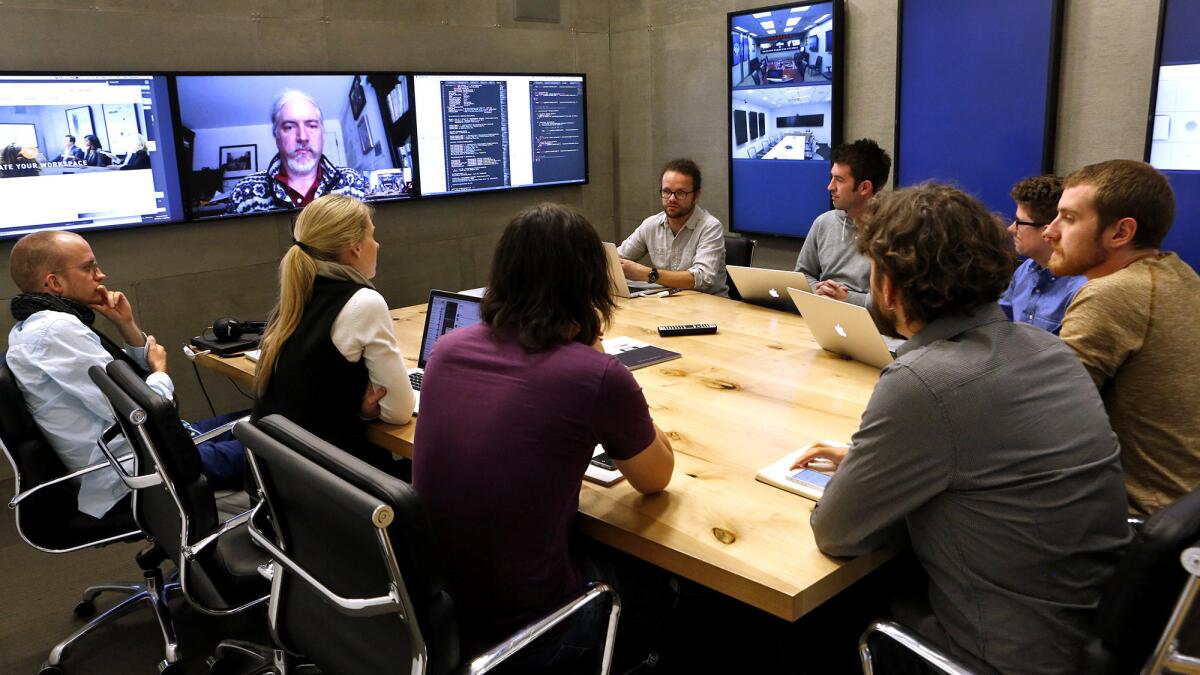Tech scene takes hold in revitalized downtown L.A.

During the L.A. tech scene’s fledgling days, entrepreneurs would joke about never going east of the 405.
Now, they’re not just venturing beyond that once-unthinkable border, they’re taking their companies with them. Like many Angelenos, they’ve become charmed by the new, revitalized downtown.
The city’s vibrant geographic core, they say, is central, cool and relatively cheap, making it a logical node in the thriving L.A. tech economy that has exploded beyond its Westside confines.
“All signs point to downtown,” said Brian Mullins, founder and chief executive of augmented reality firm Daqri, which relocated from Santa Monica two years ago. “We all believe that it’s the place in L.A. with the infrastructure to really scale a company.”
For a while, tech activity downtown skewed heavily toward e-commerce, a result of being so close to the fashion district and its manufacturing facilities. Provocative online-offline retailer Nasty Gal, style website DailyLook and luxury fashion start-up StyleSaint are just a few of the brands that bolstered downtown L.A.’s visibility as a viable tech community.
But the pool has gotten larger and more diverse, particularly in the last couple of years.
By one venture capital firm’s count, there are now 78 tech-oriented firms in DTLA. They encompass mobile apps, hardware, digital media and clean-tech companies plus co-working spaces, start-up incubators and other related businesses.
Some are brand-new, with just a couple of employees; others have been around for several years, such as NationBuilder, a community organizing software platform that launched in 2011 and has grown to more than 160 employees.
With tech hiring so competitive these days, executives say one of downtown’s biggest benefits is the ability to cast a wider net for potential employees.
“If it takes two hours to get into Venice every day, you’re not going to attract people who live in the Valley,” Mullins said. “But when you’re in downtown, you can pull people from all over L.A.”
Rents are reasonable as well. Last quarter downtown office landlords sought an average of $3.04 per square foot, according to real estate brokerage Cushman & Wakefield. That compares with $4.32 per square foot in Santa Monica.
But being in DTLA is as much about culture as it is about commutes and costs.
Tech employees skew young, and downtown plays into millennials’ desire to work and live in bustling urban environments.
Shortly after joining NationBuilder in 2012, Kai Powell moved downtown, where he currently rents a condo in the El Dorado on Spring Street, a 10-minute walk from work. He no longer owns a car, instead using Uber, Zipcar and public transportation to get around.
“There definitely is tons going on: lots of new start-ups and co-working spaces and nightlife and restaurants opening all the time,” the 29-year-old developer said. “For people who are excited by that kind of thing, I don’t think there’s any other place.”
That desire for ultra-urbanism has spilled over into downtown’s tech office spaces, with companies largely shunning skyscrapers in favor of historical buildings and abandoned industrial warehouses; a similar trend has occurred in San Francisco.
That means you won’t find many start-ups on Bunker Hill. In fact, creative companies’ interest in unusual real estate is so strong that it’s weakening traditional office occupancy rates in downtown, according to brokerage firm CBRE.
The Arts District has become one popular spot. Its gritty, industrial nature has the “same vibe and feel” as the Meatpacking District in Manhattan or SOMA in San Francisco, venture capitalist Dana Settle said. In December she moved her firm, Greycroft Partners, to a 3,000-square-foot office on East 6th Street after seven years in Santa Monica.
“We wanted to be in a space that felt entrepreneurial and a little more aligned with the entrepreneurs that we’re supporting,” she said.
A few blocks away is 9-year-old Oblong Industries, which makes a “Minority Report”-style gesture control system for conference rooms.
The firm is housed in a former railroad depot off a graffiti-splattered alley, tucked between a Latin American restaurant and a gastropub. Two mixed-use developments are under construction nearby, and an art gallery is being built in an adjacent building.
Inside, about five dozen Oblong employees work in a cavernous loft with exposed pipes, red brick walls, unfinished flooring and software code scribbled in purple marker on panes of frosted glass.
“It’s a fun and funky space — there are no cubicles,” said Mary Ann de Lares Norris, Oblong’s chief operating officer.
Another building transformed by the tech economy is the LA Mart, a longtime center for trade that in recent years added a creative space for tech and design companies. The building was rebranded the Reef, which Senior Vice President Ava Bromberg said is meant to conjure a “complete creative habitat” that spurs innovation.
General Assembly — an education institution that offers courses in tech, design and business — opened a downtown L.A. campus at the Reef in December. A venture capital firm recently leased space in the building, and over the next few months, TechShop — a chain of member-based workshops that provides access to tools, training and space — plans to build out a 20,000-square-foot facility there.
Being situated in downtown isn’t without its challenges.
Unlike Playa Vista, home to the L.A. offices of Facebook and YouTube, or Venice, home to Snapchat and boasting a sizable Google presence, DTLA has yet to draw a behemoth anchor to cement the neighborhood’s tech standing.
It has also lost out on plum tenants: Yahoo checked out downtown L.A. spaces last year, only to decide to open an office in Playa Vista.
Other problems: Converting older, non-office buildings into usable workspaces is costly. Securing enough parking spots is tough. Downtown isn’t the safest area in L.A.: Oblong’s office was robbed by two thieves who stole thousands of dollars’ worth of electronics about a year ago; more recently an employee was mugged on the way to his car.
DTLA’s emergence as a tech cluster has been coaxed along by Mayor Eric Garcetti. Although his office says it’s thrilled to welcome companies to any part of the city, it has been working closely with tech firms interested in downtown, locating office space, expediting inspections and assisting with parking issues.
“Once we have them hooked on downtown, we’re here to help,” Garcetti said.
Tech events are also drawing hundreds of far-flung entrepreneurs at a time to DTLA, even if it’s just for a day.
Santa Monica’s Upfront Ventures held a tech conference at the Ace Hotel last year. Software firm Cornerstone OnDemand, based in Santa Monica, used to hold an annual tech summit there; it moved its event to downtown L.A. in December.
Downtown’s location and public transportation options also make cross-town partnerships more feasible. More opportunities for collaboration are expected to arise once the Expo Line extension is completed.
TechSparks, a Pasadena organization that provides social forums for entrepreneurs and technologists, last year launched a new series of events in downtown L.A. The get-togethers are held at Opodz, a co-working space in Little Tokyo. TechSparks says the series has strengthened ties between Pasadena and DTLA.
That’s especially important because the Southland is so vast that no one thinks local tech will, or can, be confined to one single area. Other start-up pockets have emerged in Culver City, West L.A., El Segundo, Beverly Hills, Hollywood and beyond.
“The great thing about L.A.,” Settle said, “is that it’s such a big city and a big market and it can support multiple hubs.”
Twitter: @byandreachang
Times staff writer Roger Vincent contributed to this report.
More to Read
Inside the business of entertainment
The Wide Shot brings you news, analysis and insights on everything from streaming wars to production — and what it all means for the future.
You may occasionally receive promotional content from the Los Angeles Times.











